- Home
- Stephen Hawking
A Stubbornly Persistent Illusion Page 10
A Stubbornly Persistent Illusion Read online
Page 10
§ 3. PROPERTIES OF THE FIELD EQUATIONS OF GRAVITATION CONDITIONED BY THE THEORY OF INVARIANTS
We now introduce the assumption that
is an invariant. This determines the transformational character of the gμv. As to the transformational character of the q(ρ), which describe matter, we make no supposition. On the other hand, let the functions as well as and be invariants in relation to any substitutions of space-time co-ordinates. From these assumptions follows the general covariance of the equations (7) and (8), deduced from (1). It further follows that G (apart from a constant factor) must be equal to the scalar of Riemann’s tensor of curvature; because there is no other invariant with the properties required for G.† Thereby * is also perfectly determined, and consequently the left-hand side of field equation (7) as well.‡
From the general postulate of relativity there follow certain properties of the function * which we shall now deduce. For this purpose we carry through an infinitesimal transformation of the co-ordinates, by setting
where the Δxv are arbitrary, infinitely small functions of the co-ordinates, and are the co-ordinates, in the new system, of the world-point having the co-ordinates xv in the original system. As for the co-ordinates, so too for any other magnitude Ψ, a law of transformation holds good, of the type
where ΔΨ must always be expressible by the Δxv. From the covariant property of the gμv we easily deduce for the gμv and the laws of transformation
Since * depends only on the gμv and , it is possible, with the help of (11) and (12), to calculate Δ*. We thus obtain the equation
where for brevity we have set
From these two equations we draw two inferences which are important for what follows. We know that is an invariant with respect to any substitution, but we do not know this of It is easy to demonstrate, however, that the latter quantity is an invariant with respect to any linear substitutions of the co-ordinates. Hence it follows that the right side of (13) must always vanish if all vanish.
Consequently * must satisfy the identity
If, further, we choose the Δxv so that they differ from zero only in the interior of a given domain, but in infinitesimal proximity to the boundary they vanish, then, with the transformation in question, the value of the boundary integral occurring in equation (2) does not change. Therefore ΔF = 0, and, in consequence,†
But the left-hand side of the equation must vanish, since both and dτ are invariants. Consequently the right-hand side also vanishes. Thus, taking (14), (15), and (16) into consideration, we obtain, in the first place, the equation
Transforming this equation by two partial integrations, and having regard to the liberty of choice of the Δxσ, we obtain the identity
From the two identities (16) and (17), which result from the invariance of , and therefore from the postulate of general relativity, we now have to draw conclusions.
We first transform the field equations (7) of gravitation by mixed multiplication by gμv. We then obtain (by interchanging the indices σ and v), as equivalents of the field equations (7), the equations
where we have set
The last expression for is vindicated by (14) and (15). By differentiation of (18) with respect to xv, and summation for v, there follows, in view of (17),
Equation (21) expresses the conservation of momentum and energy. We call the components of the energy of matter, the components of the energy of the gravitational field.
Having regard to (20), there follows from the field equations (7) of gravitation, by multiplication by and summation with respect to μ and v,
or, in view of (19) and (21),
where denotes the quantities gvσ. These are four equations which the energy-components of matter have to satisfy.
It is to be emphasized that the (generally covariant) laws of conservation (21) and (22) are deduced from the field equations (7) of gravitation, in combination with the postulate of general covariance (relativity) alone, without using the field equations (8) for material phenomena.
* Four papers by Lorentz in the Publications of the Koninkl. Akad. yan Wetensch. te Amsterdam, 1915 and 1916; D. Hilbert, Göttinger Nachr., 1915, Part 3.
† No use is made for the present of the tensor character of the gμv.
† For brevity the summation symbols are omitted in the formulas. Indices occurring twice in a term are always to be taken as summed. Thus in (4), for example, denotes the term .
† Herein is to be found the reason why the general postulate of relativity leads to a very definite theory of gravitation.
‡ By performing partial integration we obtain
† By the introduction of the quantities and * instead of and *.
COSMOLOGICAL
CONSIDERATIONS ON
THE GENERAL THEORY
OF RELATIVITY
BY
A. EINSTEIN
Translated from “Kosmologische Betrachtungen zur allgemeinen Relativitätstheorie,” Sitzungsberichte der Preussischen Akad. d. Wissenschaften, 1917.
IT is well known that Poisson’s equation
in combination with the equations of motion of a material point is not as yet a perfect substitute for Newton’s theory of action at a distance. There is still to be taken into account the condition that at spatial infinity the potential ϕ tends toward a fixed limiting value. There is an analogous state of things in the theory of gravitation in general relativity. Here, too, we must supplement the differential equations by limiting conditions at spatial infinity, if we really have to regard the universe as being of infinite spatial extent.
In my treatment of the planetary problem I chose these limiting conditions in the form of the following assumption: it is possible to select a system of reference so that at spatial infinity all the gravitational potentials gμv become constant. But it is by no means evident a priori that we may lay down the same limiting conditions when we wish to take larger portions of the physical universe into consideration. In the following pages the reflexions will be given which, up to the present, I have made on this fundamentally important question.
§ 1. THE NEWTONIAN THEORY
It is well known that Newton’s limiting condition of the constant limit for ϕ at spatial infinity leads to the view that the density of matter becomes zero at infinity. For we imagine that there may be a place in universal space round about which the gravitational field of matter, viewed on a large scale, possesses spherical symmetry. It then follows from Poisson’s equation that, in order that ϕ may tend to a limit at infinity, the mean density ρ must decrease toward zero more rapidly than 1/r2 as the distance r from the centre increases.* In this sense, therefore, the universe according to Newton is finite, although it may possess an infinitely great total mass.
From this it follows in the first place that the radiation emitted by the heavenly bodies will, in part, leave the Newtonian system of the universe, passing radially outwards, to become ineffective and lost in the infinite. May not entire heavenly bodies fare likewise? It is hardly possible to give a negative answer to this question. For it follows from the assumption of a finite limit for ϕ at spatial infinity that a heavenly body with finite kinetic energy is able to reach spatial infinity by overcoming the Newtonian forces of attraction. By statistical mechanics this case must occur from time to time, as long as the total energy of the stellar system—transferred to one single star—is great enough to send that star on its journey to infinity, whence it never can return.
We might try to avoid this peculiar difficulty by assuming a very high value for the limiting potential at infinity. That would be a possible way, if the value of the gravitational potential were not itself necessarily conditioned by the heavenly bodies. The truth is that we are compelled to regard the occurrence of any great differences of potential of the gravitational field as contradicting the facts. These differences must really be of so low an order of magnitude that the stellar velocities generated by them do not exceed the velocities actually observed.
If we apply B
oltzmann’s law of distribution for gas molecules to the stars, by comparing the stellar system with a gas in thermal equilibrium, we find that the Newtonian stellar system cannot exist at all.
For there is a finite ratio of densities corresponding to the finite difference of potential between the centre and spatial infinity. A vanishing of the density at infinity thus implies a vanishing of the density at the centre.
It seems hardly possible to surmount these difficulties on the basis of the Newtonian theory. We may ask ourselves the question whether they can be removed by a modification of the Newtonian theory. First of all we will indicate a method which does not in itself claim to be taken seriously; it merely serves as a foil for what is to follow. In place of Poisson’s equation we write
where λ denotes a universal constant. If ρ0 be the uniform density of a distribution of mass, then
is a solution of equation (2). This solution would correspond to the case in which the matter of the fixed stars was distributed uniformly through space, if the density ρ0 is equal to the actual mean density of the matter in the universe. The solution then corresponds to an infinite extension of the central space, filled uniformly with matter. If, without making any change in the mean density, we imagine matter to be non-uniformly distributed locally, there will be, over and above the ϕ with the constant value of equation (3), an additional ϕ, which in the neighbourhood of denser masses will so much the more resemble the Newtonian field as λϕ is smaller in comparison with 4πκρ.
A universe so constituted would have, with respect to its gravitational field, no centre. A decrease of density in spatial infinity would not have to be assumed, but both the mean potential and mean density would remain constant to infinity. The conflict with statistical mechanics which we found in the case of the Newtonian theory is not repeated. With a definite but extremely small density, matter is in equilibrium, without any internal material forces (pressures) being required to maintain equilibrium.
§ 2. THE BOUNDARY CONDITIONS ACCORDING TO THE GENERAL THEORY OF RELATIVITY
In the present paragraph I shall conduct the reader over the road that I have myself travelled, rather a rough and winding road, because otherwise I cannot hope that he will take much interest in the result at the end of the journey. The conclusion I shall arrive at is that the field equations of gravitation which I have championed hitherto still need a slight modification, so that on the basis of the general theory of relativity those fundamental difficulties may be avoided which have been set forth in § 1 as confronting the Newtonian theory. This modification corresponds perfectly to the transition from Poisson’s equation (1) to equation (2) of § 1. We finally infer that boundary conditions in spatial infinity fall away altogether, because the universal continuum in respect of its spatial dimensions is to be viewed as a self-contained continuum of finite spatial (three-dimensional) volume.
The opinion which I entertained until recently, as to the limiting conditions to be laid down in spatial infinity, took its stand on the following considerations. In a consistent theory of relativity there can be no inertia relatively to “space,” but only an inertia of masses relatively to one another. If, therefore, I have a mass at a sufficient distance from all other masses in the universe, its inertia must fall to zero. We will try to formulate this condition mathematically.
According to the general theory of relativity the negative momentum is given by the first three components, the energy by the last component of the covariant tensor multiplied by
where, as always, we set
In the particularly perspicuous case of the possibility of choosing the system of co-ordinates so that the gravitational field at every point is spatially isotropic, we have more simply
If, moreover, at the same time
we obtain from (4), to a first approximation for small velocities,
for the components of momentum, and for the energy (in the static case)
From the expressions for the momentum, it follows that plays the part of the rest mass. As m is a constant peculiar to the point of mass, independently of its position, this expression, if we retain the condition = 1 at spatial infinity, can vanish only when A diminishes to zero, while B increases to infinity. It seems, therefore, that such a degeneration of the co-efficients gμv is required by the postulate of relativity of all inertia. This requirement implies that the potential energy m becomes infinitely great at infinity. Thus a point of mass can never leave the system; and a more detailed investigation shows that the same thing applies to light-rays. A system of the universe with such behaviour of the gravitational potentials at infinity would not therefore run the risk of wasting away which was mooted just now in connexion with the Newtonian theory.
I wish to point out that the simplifying assumptions as to the gravitational potentials on which this reasoning is based, have been introduced merely for the sake of lucidity. It is possible to find general formulations for the behaviour of the gμv at infinity which express the essentials of the question without further restrictive assumptions.
At this stage, with the kind assistance of the mathematician J. Grommer, I investigated centrally symmetrical, static gravitational fields, degenerating at infinity in the way mentioned. The gravitational potentials gμv were applied, and from them the energy-tensor Tμv of matter was calculated on the basis of the field equations of gravitation. But here it proved that for the system of the fixed stars no boundary conditions of the kind can come into question at all, as was also rightly emphasized by the astronomer de Sitter recently.
For the contravariant energy-tensor Tμv of ponderable matter is given by
where ρ is the density of matter in natural measure. With an appropriate choice of the system of co-ordinates the stellar velocities are very small in comparison with that of light. We may, therefore, substitute dx4 for ds. This shows us that all components of Tμv must be very small in comparison with the last component T44. But it was quite impossible to reconcile this condition with the chosen boundary conditions. In the retrospect this result does not appear astonishing. The fact of the small velocities of the stars allows the conclusion that wherever there are fixed stars, the gravitational potential (in our case ) can never be much greater than here on earth. This follows from statistical reasoning, exactly as in the case of the Newtonian theory. At any rate, our calculations have convinced me that such conditions of degeneration for the gμv in spatial infinity may not be postulated.
After the failure of this attempt, two possibilities next present themselves.
(a) We may require, as in the problem of the planets, that, with a suitable choice of the system of reference, the gμv in spatial infinity approximate to the values
(b) We may refrain entirely from laying down boundary conditions for spatial infinity claiming general validity; but at the spatial limit of the domain under consideration we have to give the gμv separately in each individual case, as hitherto we were accustomed to give the initial conditions for time separately.
The possibility (b) holds out no hope of solving the problem, but amounts to giving it up. This is an incontestable position, which is taken up at the present time by de Sitter.* But I must confess that such a complete resignation in this fundamental question is for me a difficult thing. I should not make up my mind to it until every effort to make headway toward a satisfactory view had proved to be vain.
Possibility (a) is unsatisfactory in more respects than one. In the first place those boundary conditions pre-suppose a definite choice of the system of reference, which is contrary to the spirit of the relativity principle. Secondly, if we adopt this view, we fail to comply with the requirement of the relativity of inertia. For the inertia of a material point of mass m (in natural measure) depends upon the gμv; but these differ but little from their postulated values, as given above, for spatial infinity. Thus inertia would indeed be influenced, but would not be conditioned by matter (present in finite space). If only one single point of mass were present, according to this view,
it would possess inertia, and in fact an inertia almost as great as when it is surrounded by the other masses of the actual universe. Finally, those statistical objections must be raised against this view which were mentioned in respect of the Newtonian theory.
From what has now been said it will be seen that I have not succeeded in formulating boundary conditions for spatial infinity. Nevertheless, there is still a possible way out, without resigning as suggested under (b). For if it were possible to regard the universe as a continuum which is finite (closed) with respect to its spatial dimensions, we should have no need at all of any such boundary conditions. We shall proceed to show that both the general postulate of relativity and the fact of the small stellar velocities are compatible with the hypothesis of a spatially finite universe; though certainly, in order to carry through this idea, we need a generalizing modification of the field equations of gravitation.
§ 3. THE SPATIALLY FINITE UNIVERSE WITH A UNIFORM DISTRIBUTION OF MATTER
According to the general theory of relativity the metrical character (curvature) of the four-dimensional space-time continuum is defined at every point by the matter at that point and the state of that matter. Therefore, on account of the lack of uniformity in the distribution of matter, the metrical structure of this continuum must necessarily be extremely complicated. But if we are concerned with the structure only on a large scale, we may represent matter to ourselves as being uniformly distributed over enormous spaces, so that its density of distribution is a variable function which varies extremely slowly. Thus our procedure will somewhat resemble that of the geodesists who, by means of an ellipsoid, approximate to the shape of the earth’s surface, which on a small scale is extremely complicated.

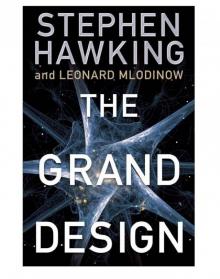 The Grand Design
The Grand Design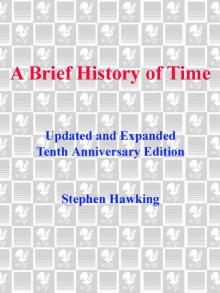 A Brief History of Time
A Brief History of Time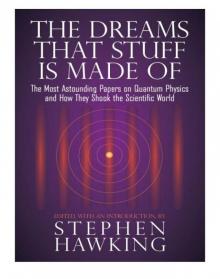 The Dreams That Stuff is Made of
The Dreams That Stuff is Made of My Brief History
My Brief History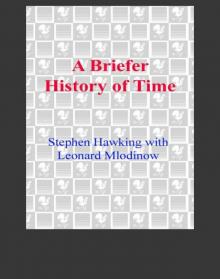 A Briefer History of Time
A Briefer History of Time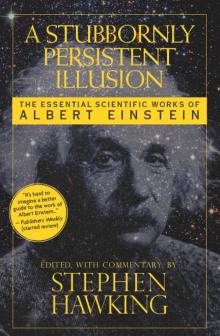 A Stubbornly Persistent Illusion
A Stubbornly Persistent Illusion George and the Blue Moon
George and the Blue Moon George and the Unbreakable Code
George and the Unbreakable Code Brief Answers to the Big Questions
Brief Answers to the Big Questions George's Secret Key to the Universe
George's Secret Key to the Universe